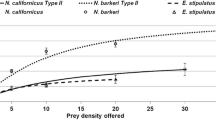Abstract
A survey was conducted to identify possible alternative plant habitats of the most common phytoseiid predators associated with the cassava green mite, Mononychellus tanajoa (Bondar), in their native environment in northeast Brazil. Thirty-two phytoseiid species were collected, including Amblyseius aripo (DeLeon), Amblyseius idaeus (Denmark and Muma) and Amblyseius limonicus Garman and McGregor s.l., the three predators previously shown as the most common on cassava. In increasing order, A. idaeus, Phytoseius guianensis DeLeon and A. aripo were the most common phytoseiids collected on the plant habitats examined. A. limonicus s.l. was one of the least common phytoseiids on plants other than cassava. Altermative plant habitats seem important in harboring A. aripo and A. idaeus, but not A. limonicus s.l..
Similar content being viewed by others
References
DelucchiV., 1989. Integrated pest management vs systems management. In: J.S.Yaninek and H.R.Herren (Editors), Biological control: a sustainable solution to crop pest problems in Africa. International Institute of Tropical Agriculture, Ibadan, Nigeria, pp. 51–67.
HuangMing-Dau; MaiSiu-Wui and LiShu-Xin, 1981. Biological control of citrus red mite, Panonychus citri (McG.) in Guangdong Province. Proc. Int. Soc. Citriculture, 2: 643–646.
MackauerM., 1989. Biological control in the context of systems management. In: J.S.Yaninek and H.R.Herren (Editors), Biological control: a sustainable solution to crop pest problems in Africa. International Institute of Tropical Agriculture, Ibadan, Nigeria, pp. 51–67.
MoraesG.J.de and McMurtryJ.A., 1983. Phytoseiid mites (Acarina) of northeastern Brazil with descriptions of four new species. International Journal of Acarology 9: 131–148.
Moraes, G.J. de; Braun, A.R.; Yaninek, J.S. and Alencar, J.A. de, 1990. Preliminary selection of predators of the cassava green mite (Acari: Tetranychidae) in Brazil for introduction into Africa. In: Abstracts VIII International Congress of Acarology, August 6–11, 1990, Ceske Budejovice, Czechoslovakia, p. 108.
MoraesG.J.de; McMurtryJ.A. and DenmarkH.A., 1986. A catalog of the mite family Phytoseiidae. References to taxonomy, synonymy, distribution and habitat. EMBRAPA, Brasilia, 353 p.
RoggH.W. and YaninekJ.S., 1990. Population dynamics of Typhlodromalus limonicus from Colombia, an introduced predator of the exotic cassava green mite in West Africa. Bulletin Societe Entomologique Suisse 63: 389–398.
Author information
Authors and Affiliations
Rights and permissions
About this article
Cite this article
de Moraes, G.J., de Alencar, J.A., de Lima, J.L.S. et al. Alternative plant habitats for common phytoseiid predators of the cassava green mite (Acari: Phytoseiidae, Tetranychidae) in northeast Brazil. Exp Appl Acarol 17, 77–90 (1993). https://doi.org/10.1007/BF00156945
Issue Date:
DOI: https://doi.org/10.1007/BF00156945




